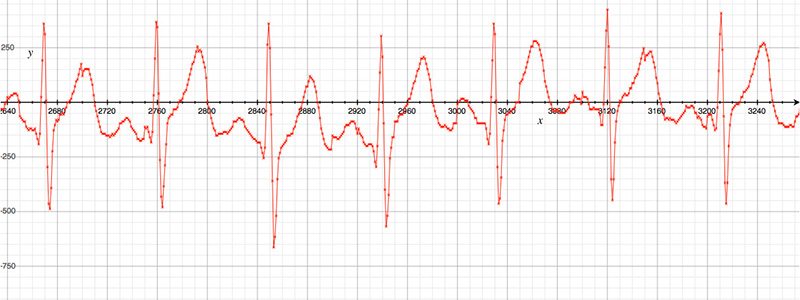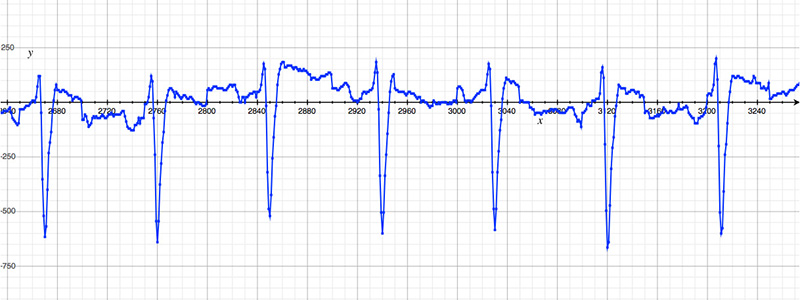Holter ECG .dat fileWritten by Paul BourkeJuly 2018
A Holter recorder is an ambulatory electrocardiography device for, most commonly, measuring ECG for possibly many days. Software is provided that analyses the signals calculating various metrics common in the industry. However, the system and software is proprietary, it does not even seem to offer any facility to export the raw data in a format that is useful for independent analysis or research. In the authors opinion this is totally unconscionable behaviour, while it may be reasonable to protect algorithms and IP involved in the analysis, the raw data could reasonably be expected to be the property of the person who purchased the recording equipment, or the person whose ECG was recorded. 
But there is a way around this. The recorder stores the original recording in a "flash.dat" file. While parts of this file can be decoded, there are aspects that are as yet not understood. Indeed since the LX Analysis software seems to be built upon Matlab it may be that there are MatLab conventions and file writing details involved. The file would in the very least be quite inefficient to deal with for analysis. So, the very first time the LX Analysis software reads the flash.dat file it creates a bunch of other files, each containing a specific aspect of the data. One of the files so created is called "datacard.dat", this contains the ECG samples of the N channels recorded, typically 2 or 3. As long as this datacard.dat file exists then it is relatively easy, albeit messy, to extract the samples. Behind the scenes the installer of LX Analysis (this includes the free demo version) installs some utilities, one is called unpackdc (unpack data card). This creates a simple 2 byte per sample binary file per channel that is then easy to read and write in a more useful format for other software. The usage string for unpackdc is
unpackdc datacard_file_name channel_one channel_two channel_three type [g1] [g2] [g3] [sample-rate]
uses as input/output the file in datacard.dat format datacard_file_name
(full path must be specified)
channel_xxx is the name of the input/output file for channel xxx
if channel_xxx_file_name is set to - then that channel is not converted
the converted channels are input/output as 16 bit binary data with the least
significant bit equal to 12.5 micro volt (assuming calibrated data )
type is:
0 for converting from datacard to 16 bit
2 for converting from 2 channels to datacard
3 for converting to a 3 channel datacard file
4 for a single file(channel_one file) of 16 bit data organized as
3 sequential 16 bit int's for the three channels for each sample.
g1 g2 and g3 are optional arguments which specify the gain to be used
in the conversion 1.0 is unity gain with a allowed range of
0.125 to 8.0. The gain setting is not supported for type 4
sample rate is a optional argument indicating the sampling rate of the
source date for modes 2 and 3. It must 180 or greater samples per second
The process then for extracting the data from a Holter recording is as follows

Note
There are international standards for recording medical data, including ECG data. Indeed one has the Holter name associated with it, namely the Holter ECG Standard, clearly they are just paying lip service to the idea of international standards if they don't even support their own format as an export option. Be aware
If you are buying expensive hardware for measuring X, and associated expensive software, insist upfront or as part of the tendering process that you have access to the raw data and in it's full resolution ... if indeed you might want to use the recorded data outside the ecosystem the supplier provides. ChallengeFor the data wranglers out there you will appreciate that running two bits of code to extract a text version of a data format is rather messy. Much more elegant would be to be able to read the datacard.dat files directly. To date the format has not been reverse engineered. There are some useful things known about the format, first, it has a fixed number of bits per sample so it is not compressed in a data dependent way like run length encoding or other more complex compressions. For those who might like to take up the challenge and earn the awe and respect of ECG researchers internationally here are some examples and information.
|